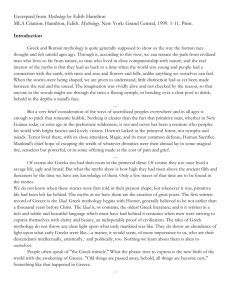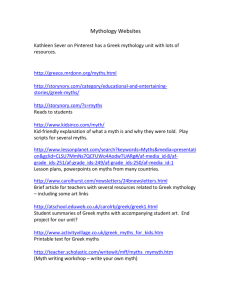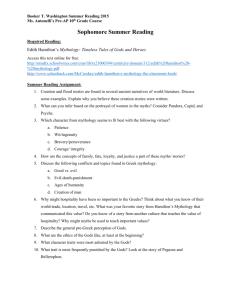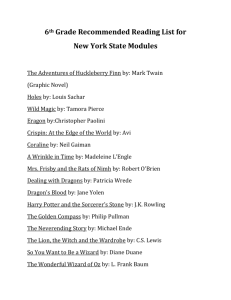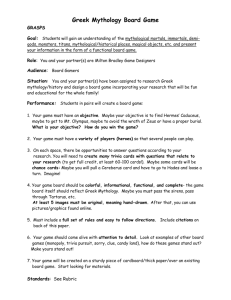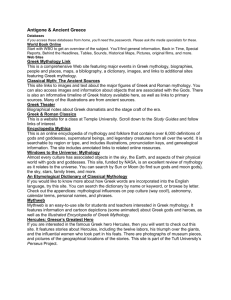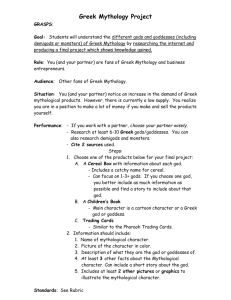2014-IB-Summer-Mythology-Asssignment
advertisement
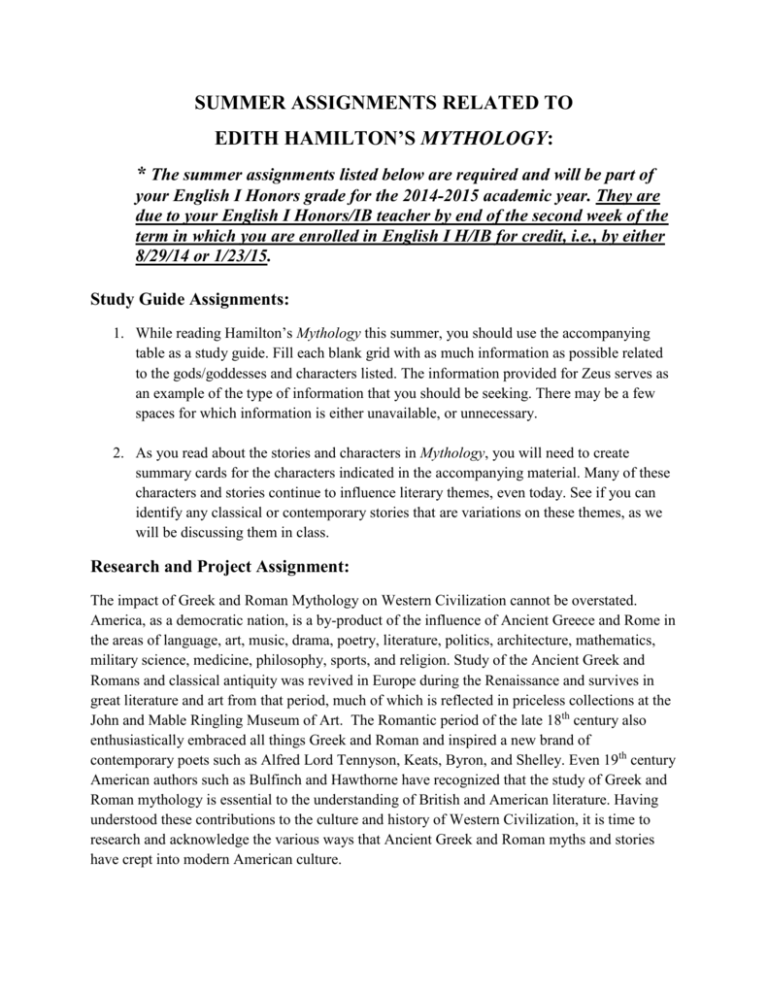
SUMMER ASSIGNMENTS RELATED TO EDITH HAMILTON’S MYTHOLOGY: * The summer assignments listed below are required and will be part of your English I Honors grade for the 2014-2015 academic year. They are due to your English I Honors/IB teacher by end of the second week of the term in which you are enrolled in English I H/IB for credit, i.e., by either 8/29/14 or 1/23/15. Study Guide Assignments: 1. While reading Hamilton’s Mythology this summer, you should use the accompanying table as a study guide. Fill each blank grid with as much information as possible related to the gods/goddesses and characters listed. The information provided for Zeus serves as an example of the type of information that you should be seeking. There may be a few spaces for which information is either unavailable, or unnecessary. 2. As you read about the stories and characters in Mythology, you will need to create summary cards for the characters indicated in the accompanying material. Many of these characters and stories continue to influence literary themes, even today. See if you can identify any classical or contemporary stories that are variations on these themes, as we will be discussing them in class. Research and Project Assignment: The impact of Greek and Roman Mythology on Western Civilization cannot be overstated. America, as a democratic nation, is a by-product of the influence of Ancient Greece and Rome in the areas of language, art, music, drama, poetry, literature, politics, architecture, mathematics, military science, medicine, philosophy, sports, and religion. Study of the Ancient Greek and Romans and classical antiquity was revived in Europe during the Renaissance and survives in great literature and art from that period, much of which is reflected in priceless collections at the John and Mable Ringling Museum of Art. The Romantic period of the late 18th century also enthusiastically embraced all things Greek and Roman and inspired a new brand of contemporary poets such as Alfred Lord Tennyson, Keats, Byron, and Shelley. Even 19th century American authors such as Bulfinch and Hawthorne have recognized that the study of Greek and Roman mythology is essential to the understanding of British and American literature. Having understood these contributions to the culture and history of Western Civilization, it is time to research and acknowledge the various ways that Ancient Greek and Roman myths and stories have crept into modern American culture. Task: Many modern products, businesses, inventions, and discoveries that we use or refer to on a daily basis carry the names of Greek and Roman gods, goddesses, mythological creatures, and heroes/heroines. Your task is to identify some of these products, businesses, inventions, and discoveries and explain why each specific name was chosen. Example: In the Trojan War, described by Homer in his epic poem The Iliad, Ajax is the tallest and strongest of all the Achaean warriors who fight the Trojans. Trained by the centaur Chiron, he battles with a great hammer and huge shield made of ox-hides and bronze. Though not as skilled in arms, perhaps, as the better known hero Achilles, he does not die by the hand of any other warrior during the war. In 1947, corporate conglomerate Colgate–Palmolive introduced a new cleanser called Ajax that it claimed was “stronger than dirt.” Later, it used the same slogan to introduce its laundry detergent version of the cleaner. When its first commercial ran on TV the following year, the jingle Americans heard was “You'll stop paying the elbow tax, when you start cleaning with Ajax,” an allusion to the strength of the Greek warrior Ajax that suggested to consumers that, with this product, no “elbow grease” was needed. Requirements: A minimum of 12 products, businesses, inventions, and/or discoveries must be included in order to get full credit. In addition to identifying the product, business, invention, and/or discovery, you must explain the relationship of its name to Greek or Roman mythology, and why the name was chosen, i.e., recap the Greek or Roman myth that makes it an appropriate choice, as illustrated in the example above. Each of your submissions must include an illustration of the product, business, invention, and/or discovery. Illustrations may be drawn by hand, computer generated (e.g., via Power Point presentation), or taken from the product itself. You should graphically display your work either in Power Point or on a poster board with detailed explanations accompanying each illustration. All work should be neat, colorful, and aesthetically pleasing to the eye. It will be necessary for you to independently research some of the products, businesses, inventions, and/or discoveries as they relate to Greek and Roman myths and legends. Those students not having access at home to computers for research should access materials from a county library. Writing Assignments: 1. A “myth” is a story, and the word is derived from the Greek word “mythos” meaning story. The word mythology comes from the Greek word “mythos” and the Greek word “logos,” meaning word, speech, or reason. In addition, the English suffix -ology or -logy usually refers to a field of study or academic discipline. Thus, in most cultures, myths originated as stories passed down from generation to generation through oral tradition. Understandably, they developed and evolved over time, resulting in slightly different versions of the same basic themes. Eventually, many myths were turned into poems and songs that were reduced to writing by mythographers, and are now studied in mythology.. It is important to recognize that myths are not necessarily intended to be interpreted literally. They often contain archetypes important to a specific culture and are related as allegories and parables designed to provide deeper meaning by analogy and comparison. Mythology is a way of understanding the world and providing a set of values, and just because myths are not always supported by scientific and historical proofs does not make them any less valuable to a culture. There are many things in life that are not subject to proof, but man will always seek to understand. Most myths contain tales of adventure involving heroes and heroines, as well as events that explain natural phenomena. Mythic characters and animals may also have superhuman or supernatural abilities. So how do myths differ from legends, fairytales, and folktales? Why are they considered different genres of “storytelling?” Reflect upon the similarities and differences between these genres and write a one page (typed, double-spaced) essay explaining how myths are distinctly unique from the other categories mentioned. 2. Swiss Psychotherapist and Psychologist Carl Jung is well-known for his theory of archetypes and the collective unconscious, as well as his study of the human psyche. Through Greek myths, we know that the Greek gods and goddesses exhibited extremely human traits that might be considered both positive and negative. According to Jung, individual gods and goddesses in the pantheon, along with their related symbols, represent different archetypes for the human psyche and personality that exist unconsciously in all of us. An “archetype” is an original model or type after which other similar things are patterned, while the word “psyche” originates from the Greek word for Soul. Which gods and goddesses most reflect your own inner world? Write a two page (typed, double-spaced) essay detailing how and why certain gods/goddesses might serve as your psychological archetypes. Draw upon specific traits of the deities and compare them to your own, providing concrete examples from Greek myths that you have read.

